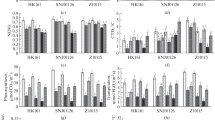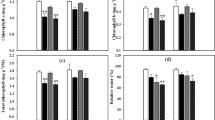Abstract
Drought stress is one of the major environmental factors responsible for reduction in crop productivity. In the present study, responses of two maize cultivars (Rung Nong 35 and Dong Dan 80) were examined to explicate the growth, yield, leaf gas exchange, leaf water contents, osmolyte accumulation, membrane lipid peroxidation, and antioxidant activity under progressive drought stress. Maize cultivars were subjected to varying field capacities (FC) viz., well-watered (80 % FC) and drought-stressed (35 % FC) at 45 days after sowing. The effects of drought stress were analyzed at 5, 10, 15, 20, ad 25 days after drought stress (DAS) imposition. Under prolonged drought stress, Rung Nong 35 exhibited higher reduction in growth and yield as compared to Dong Dan 80. Maize cultivar Dong Dan 80 showed higher leaf relative water content (RWC), free proline, and total carbohydrate accumulation than Run Nong 35. Malondialdehyde (MDA) and superoxide anion were increased with prolongation of drought stress, with higher rates in cultivar Run Nong 35 than cultivar Dong Dan 80. Higher production of superoxide dismutase (SOD), peroxidase (POD), and catalase (CAT) and glutathione reductase (GR) resulted in improved growth and yield in Dong Dan 80. Overall, the cultivar Dong Dan 80 was better able to resist the detrimental effects of progressive drought stress as indicated by better growth and yield due to higher antioxidant enzymes, reduced lipid peroxidation, better accumulation of osmolytes, and maintenance of tissue water contents.





Similar content being viewed by others
References
Anjum SA, Farooq M, Wang LC, Xue LL, Wang SG, Wang L, Zhang S, Chen M (2011a) Gas exchange and chlorophyll synthesis of maize cultivars are enhanced by exogenously-applied glycinebetaine under drought conditions. Plant Soil Environ 57:326–331
Anjum SA, Xie XY, Wang LC, Saleem MF, Man C, Lei CW (2011b) Morphological, physiological and biochemical responses of plants to drought stress. Afr J Agr Res 6:2026–2032
Anjum SA, Farooq M, Xie X, Liu XJ, Ijaz MF (2012) Antioxidant defense system and proline accumulation enables hot pepper to perform better under drought. Sci Hort 140:66–73
Anjum SA, Tanveer M, Hussain S, Bao M, Wang LC, Khan I, Ullah E, Tung SA, Samad RA, Shahzad B (2015) Cadmium toxicity in Maize (Zea mays L.): consequences on antioxidative systems, reactive oxygen species and cadmium accumulation. Env Sci Poll Res 22:17022–17030
Ashraf M, Foolad MR (2007) Roles of glycine betaine and proline in improving plant abiotic stress resistance. Environ Exp Bot 59:206–216
Aslam M, Zamir MSI, Anjum SA, Khan I, Tanveer M (2014) An investigation into morphological and physiological approaches to screen maize (Zea mays L.) cultivars for drought tolerance. Cereal Res Commun 43:41–51
Basu S, Roychoudhury A, Saha PP, Sengupta DN (2010) Differential antioxidative response of indica rice cultivars to drought stress. Plant Growth Regul 60:51–59
Bates LS, Waldren RP, Teare ID (1973) Rapid determination of free proline for water-stress studies. Plant Soil 39:205–207
Blokhina O, Virolainen E, Gagerstedt KV (2003) Antioxidants, oxidative damage and oxygen deprivation stress: a review. Ann Bot 91:179–194
Chaves MM, Maroco JP, Pereira JS (2003) Understanding plant responses to drought—from genes to the whole plant. Funct Plant Biol 30:239–264
Cia MC, Guimarães ACR, Medici LQ, Chabregas SM, Azevedo RA (2012) Antioxidant response to water deficit by drought-tolerant and sensitive sugarcane varieties. Ann Appl Biol 161:313–324
Dhindsa RS, Plumb-Dhindsa P, Thorpe TA (1981) Leaf senescence: correlated with increased levels of membrane permeability and lipid peroxidation, and decreased levels of superoxide dismutase and catalase. J Exp Bot 32:93–101
Dubois M, Gilles KA, Hamilton JK, Rebers P, Smith F (1956) Colorimetric method for determination of sugars and related substances. Analytical chemistry 28(3):350–356
Erice G, Louahlia S, Irigoyen JJ, Sanchez-Diaz M, Avice JC (2010) Biomass partitioning, morphology and water status of four alfalfa genotypes submitted to progressive drought and subsequent recovery. J Plant Physiol 167:114–120
Farooq M, Wahid A, Kobayashi N, Fujita D, Basra SMA (2009) Plant drought stress: effects, mechanisms and management. Agron Sustain Develop 29:185–212
Feng Z, Jin-Kui G, Ying-Li Y, Wen-Liang H, Li-Xin Z (2004) Changes in the pattern of antioxidant enzymes in wheat exposed to water deficit and rewatering. Acta Physiol Plant 26:345–352
Jiang Y, Huang B (2002) Protein alterations in tall fescue in response to drought stress and abscisic acid. Crop Science 42(1):202–207
Halder KP, Burrage SW (2003) Drought stress effects on water relations of rice grown in nutrient film technique. Pak J Biol Sci 6:441–444
Keenan T, Sabate S, Gracia C (2010) The importance of mesophyll conductance in regulating forest ecosystem productivity during drought periods. Global Change Biol 16:1019–1034
Khaliq A, Aslam F, Matloob A, Hussain S, Geng M, Wahid A, Rehman H (2015) Seed priming with selenium: consequences for emergence, seedling growth, and biochemical attributes of rice. Biol Trace Element Res 166:236–244
Kishor PK, Sangam S, Amrutha RN, Laxmi PS, Naidu KR, Rao KRSS, Sreenivasulu N (2005) Regulation of proline biosynthesis, degradation, uptake and transport in higher plants: its implications in plant growth and abiotic stress tolerance. Curr Sci 88(3):424–438
Mittler R (2002) Oxidative stress, antioxidants and stress tolerance. Trends Plant Sci 7:405–410
Noctor G, Foyer CH (1998) Ascorbate and glutathione: keeping active oxygen under control. Ann Rev Plant Biol 49:249–279
Queiroz JB, Santosd MM, Ferraudoa S, Carlins D, Silva MA (2011) Biochemical and physiological responses of sugarcane cultivars to soil water deficiencies. Sci Agric 68:469–476
Sairam RK, Saxena, DC (2000) Oxidative stress and antioxidants in wheat genotypes: possible mechanism of water stress tolerance. Journal of Agronomy and Crop Science 184(1):55–61
Sairam RK, Srivastava GC (2001) Water stress tolerance of wheat (Triticum aestivum L.): variations in hydrogen peroxide accumulation and antioxidant activity in tolerant and susceptible genotypes. Journal of Agronomy and Crop Science 186(1):63–70
Sanchez-Rodriguez E, Rubio WM, Cervilla LM, Blasco B, Rios JJ, Rosales MA, Romero L, Ruiz JM (2010) Genotypic differences in some physiological parameters symptomatic for oxidative stress under moderate drought in tomato plants. Plant Sci 178:30–40
Sengupta D, Anirban G, Attipalli RR (2013) Interdependence of plant water status with photosynthetic performance and root defense responses in (Vigna radiate L.) Wilczek under progressive drought stress and recovery. J Photochem Photobiol B127:170–181
Sharma P, Dubey RS (2005) Drought induces oxidative stress and enhances the activities of antioxidant enzymes in growing rice seedlings. Plant Grow Regul 46:209–221
Siddique MRB, Hamid A, Islam MS (2000) Drought stress effects on water relations of wheat. Bot Bull Acad Sin 41:35–39
Simova SL, Demirevska K, Petrova T, Tsenov N, Feller U (2008) Antioxidative protection in wheat cultivars under severe recoverable drought at seedling stage. Plant Soil Environ 54:529–536
Smirnoff N, Cumbes QJ (1989) Hydroxyl radicals scavenging activity of compatible solutes. Phytochem 828:1057–1060
Smith DB, Johnson KS (1988) Single-step purification of polypeptides expressed in Escherichia coli as fusions with glutathione S-transferase. Gene 67(1):31–40
Veihmeyer FJ, Hendrickson AH (1949) Methods of measuring field capacity and permanent wilting percentage of soils. Soil Sci 68:75–94
Vendruscolo ECG, Schuster I, Pileggi M, Scapim CA, Molinari HBC, Marur CJ, Esteves VLG (2007) Stress-induced synthesis of proline confers tolerance to water deficit in transgenic wheat. J Plant Physiol 164:1367–1376
Wu QS, Xia RX, Zou YN (2008) Improved soil structure and citrus growth after inoculation with three arbuscular mycorrhizal fungi under drought stress. Eur J Soil Biol 44:122–128
Author information
Authors and Affiliations
Corresponding author
Additional information
Responsible editor: Philippe Garrigues
Rights and permissions
About this article
Cite this article
Anjum, S.A., Tanveer, M., Ashraf, U. et al. Effect of progressive drought stress on growth, leaf gas exchange, and antioxidant production in two maize cultivars. Environ Sci Pollut Res 23, 17132–17141 (2016). https://doi.org/10.1007/s11356-016-6894-8
Received:
Accepted:
Published:
Issue Date:
DOI: https://doi.org/10.1007/s11356-016-6894-8




